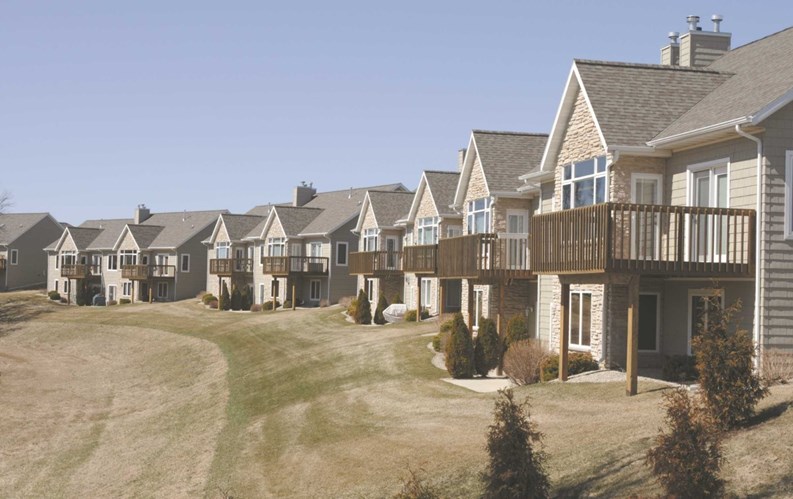When you consider all the different components that a condo association has to deal with, decks are sort of like the Rodney Dangerfield of the list; they rarely get any respect.
“Decks are definitely something that people don’t pay enough attention to,” says Gustavo De la Cruz, owner of Barrett Contracting, a deck design company in Millstone Township. “Most owners are not informed, or do not make the investment of proper maintenance of their decks.”
Many of New Jersey’s condominium decks were built 10 to 20 years ago, and are now nearing the end of their useful life—especially if they haven’t been maintained properly over the years. This is especially true in coastal towns along the Jersey Shore, where salty sea air can wreak havoc on wood.
Out With the Old
In the current economic climate, most condo boards aren’t thinking about making changes to their decks, especially if nothing is visibly wrong with them. Even with a steady maintenance program however, wooden decks eventually deteriorate and may need to be repaired or replaced. Luckily, a host of new technologies are available to make deck construction and future maintenance a bit easier.
“It’s extremely important not only to have a maintenance program but to realize when you’re planning on building your deck, the maintenance that is going to be required,” says Gary Daley, owner of Deck Builder Custom Decks & Railings in Toms River.
“Many times, people will think that they are getting value by getting a cheaper deck, but that less-expensive deck may require more expensive maintenance. If the owner does not keep up with the maintenance, then the value is lost.”
Composite decking was developed around 1990 by the Winchester, Virginia-based company Trex, and is essentially a pressure-treated mixture of wood and plastic molded into the desired form. Unlike traditional woods, composite decks are constructed with screw-type sink fasteners or with blind fasteners, which are hidden pieces into which the composite boards are attached with clips. These decks are finished off with railings that can be coated in nearly any color, and imprinted with textures that exactly mimic the appearance of wood. These pressure-treated softwoods or low-end woods are heavily in demand in the New Jersey area as more people tend to be moving away from the traditional wooden deck, says Daley.
“Some softwoods like cedar decks can rot out in less than 10 years, even with the best maintenance,” adds De la Cruz. “Low maintenance products like composites and PVC can last, at least structurally, 20 years or more. Trex is very popular in our region. While most of the country is still mostly using pressure-treated pine, builders like ourselves can see as much as 95% of our work involving low-maintenance products like Trex and Fiberon. But capped or shell composites are the way the decking market is moving towards very quickly, along with LED lights and shade structures.”
Treatment Time
Pressure-treated lumber needs to be allowed to dry for several months before sealing or staining. In most cases, the maintenance depends on the weather.“If a wooden deck is located in direct sunlight for extended periods of time or most of the day, then the deck will dry out and crack as the light and heat take their toll on the stain and sealer,” De la Cruz says. “Most likely the deck should be stained every year or two depending on the stain. A solid stain will last longer than a transparent stain.”
Most composites that have been installed over the past 10 years require maintenance only once or twice a year to remove accumulated oils, pollen, grease and mold.
“If you were to spill a drink on a composite deck it wouldn't stain,” says Daley. “But even if you just sat a potato chip down on a wood-based composite deck in the sun after an hour the grease from that potato chip would absorb into the wood and stain it.”
“With ultra-low maintenance products, it is as easy as just periodical power wash cleanings,” says De la Cruz. “However, regular cleaning is just as important. Imagine not washing your car or not taking care of a spill on your very beautiful and expensive indoor flooring. Decks require just as much attention, but most people don’t realize it.”
Inspect and Report
If your condo hasn’t had an inspection lately, it’s a good way to figure out if something needs to be fixed. The North American Deck and Railing Association (NADRA) is dedicated to increasing public awareness of the necessity for regular inspection and maintenance of existing decks and proper installation of new decks.
“A professional inspection will examine every inch of your deck, provide information on your deck’s capacity limits, identify any dangerous problem areas and give you a map of what to keep your eye on in the future,” says Mike Beaudry, executive vice president for NADRA. “If your deck is older, this might include a regular deck inspection schedule.”
The inspection includes key areas such as ledger connections, posts and footings, post-to-beam connections, joists and joist connections, stairs, deck boards, handrail assemblies and guards. An inspector will be on the lookout for telltale signs of rot and structural issues. Especially in older buildings, layers of paint or stain on a deck may be hiding water damage or decay, making the problem worse over time. Without the right protection and sealants, moisture and salt can do a lot to lessen the life span of a wooden deck.
Other important things that need to be looked for include cracking, splitting, splintering, loose nails, loose railings, twisted posts and broken balusters. ”It’s also important to have deck structures inspected from below,” says De la Cruz, “Especially if it is an elevated deck.”
When deck failures take place, the water rots out the plywood and frame of the structure that the deck is attached to. The deck is now failing and becoming extremely dangerous with a great potential to fall off and cause injury or even death.
“If you jump on a deck and it bounces you need to have it looked at by a professional,” says Daley. “If it bounces the structure is not sound. Either it was not built right or maybe it deteriorated to the point that it’s near collapse. So if your deck is bouncy, sagging or if it sways, if there’s any movement at all, you need to get a professional in right away. Railings also should not be wobbly. You have to be careful. If a deck goes down with a bunch of people, a grill and a couple of coolers of beer, people will get hurt.”
Insurance Issues
Deck collapses—although generally not as dangerous or deadly as balcony collapses on mid- or high-rise buildings—can cause injury to people and expensive damage to the building the deck is attached to. And of course, anytime the words 'injury' and 'damage' come into the picture, so do issues of liability, insurance, and claims.
“It’s important to understand who is responsible for the maintenance of the deck,” says Diane Spiers of State Farm Insurance in Manalapan. “The maintenance is usually the association’s responsibility.”
“There is no special insurance to cover the collapse of a balcony or deck,” Spiers continues. “That would more than likely fall under the building coverage. Each policy has building and personal property and liability coverage. So anything that has to do with the building—the frame of the building—that’s part of building coverage.”
There are two pieces to the insurance puzzle. First is the physical structure that collapsed. It would need to be replaced. That would be covered under the condominium’s property coverage. Second would be any injury or third-party property damage as a result of the collapse. That would be covered under the condominium’s general liability policy.
“If the injury or property damage went beyond the limits of the general liability policy, the unit owner could sue the Association or the builder for the difference,” Spiers says. Depending on the situation and how the condo outlines the responsibilities for the care and maintenance of the decks, the unit owners themselves could be held responsible.
A scheduled program of inspection, maintenance and repair can prevent damage to people, property, and the association’s finances. Those decks, do, after all, deserve some respect.
Keith Loria is a freelance writer and a frequent contributor to The New Jersey Cooperator. Editorial assistant Christy Smith-Sloman contributed to this article.







Leave a Comment